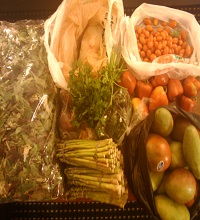Seafood (3)
 Gumbo is typically a "peasant dish" meaning that it is constructed with whatever you have on hand. With one exception: the word "Gumbo" is said to come from an old African word for Okra. As a result, true Gumbo should always include Okra. There are a few different types of Gumbo. This recipe will focus on Creole Gumbo and would traditionally include seafood and tomatoes. For a more spicy, darker colored Gumbo, try Cajun Gumbo.
Gumbo is typically a "peasant dish" meaning that it is constructed with whatever you have on hand. With one exception: the word "Gumbo" is said to come from an old African word for Okra. As a result, true Gumbo should always include Okra. There are a few different types of Gumbo. This recipe will focus on Creole Gumbo and would traditionally include seafood and tomatoes. For a more spicy, darker colored Gumbo, try Cajun Gumbo.
Sous Vide (pronounced \Soo Vee\) is a cooking process that involves placing the food in a hermetically sealed bag and submersing it in water. The water can be heated to a specific temperature for long periods, resulting in a final product that is juicy and tender. This article provides general guidelines on using a Sous Vide to prepare various cuts of meat. The Cooking Temperature will determine the "doneness" of the meat. To ensure food safety, never use a cooking time/temperature that is lower than the value on the Pasteurization Chart listed below. Any whole fowl should be spatchcocked or quartered before cooking by Sous Vide. The recommendations listed here are based on my own experiences. Your mileage may vary.
 Jambalaya is a traditional recipe from New Orleans that is similar to Gumbo, but it is not a soup. Jambalaya is typically made in a single pot and comes in a couple of variants: "Red" Jambalaya (also called "Creole" Jambalaya) or Cajun Jambalaya. Each Jambalaya also incorporates a different set of seasonings. Red Jambalaya includes tomatoes. Cajun Jambalaya is typically a more spicy (hot) dish, and may also contain meats with blackened pepper. Here is a great recipe for a traditional Red (or Creole) Jambalaya. This recipe has a pretty large yield. The leftovers can be stored in the refrigerator for up to 1 week. But it seems like that is never a problem. In my experience, the leftovers will be eaten long before it has time to go bad.
Jambalaya is a traditional recipe from New Orleans that is similar to Gumbo, but it is not a soup. Jambalaya is typically made in a single pot and comes in a couple of variants: "Red" Jambalaya (also called "Creole" Jambalaya) or Cajun Jambalaya. Each Jambalaya also incorporates a different set of seasonings. Red Jambalaya includes tomatoes. Cajun Jambalaya is typically a more spicy (hot) dish, and may also contain meats with blackened pepper. Here is a great recipe for a traditional Red (or Creole) Jambalaya. This recipe has a pretty large yield. The leftovers can be stored in the refrigerator for up to 1 week. But it seems like that is never a problem. In my experience, the leftovers will be eaten long before it has time to go bad.


 Gumbo is typically a "peasant dish" meaning that it is constructed with whatever you have on hand. With one exception: the word "Gumbo" is said to come from an old African word for Okra. As a result, true Gumbo should always include Okra. There are a few different types of Gumbo. This recipe will focus on Creole Gumbo and would traditionally include seafood and tomatoes. For a more spicy, darker colored Gumbo, try Cajun Gumbo.
Gumbo is typically a "peasant dish" meaning that it is constructed with whatever you have on hand. With one exception: the word "Gumbo" is said to come from an old African word for Okra. As a result, true Gumbo should always include Okra. There are a few different types of Gumbo. This recipe will focus on Creole Gumbo and would traditionally include seafood and tomatoes. For a more spicy, darker colored Gumbo, try Cajun Gumbo.
 Jambalaya is a traditional recipe from New Orleans that is similar to Gumbo, but it is not a soup. Jambalaya is typically made in a single pot and comes in a couple of variants: "Red" Jambalaya (also called "Creole" Jambalaya) or Cajun Jambalaya. Each Jambalaya also incorporates a different set of seasonings. Red Jambalaya includes tomatoes. Cajun Jambalaya is typically a more spicy (hot) dish, and may also contain meats with blackened pepper. Here is a great recipe for a traditional Red (or Creole) Jambalaya. This recipe has a pretty large yield. The leftovers can be stored in the refrigerator for up to 1 week. But it seems like that is never a problem. In my experience, the leftovers will be eaten long before it has time to go bad.
Jambalaya is a traditional recipe from New Orleans that is similar to Gumbo, but it is not a soup. Jambalaya is typically made in a single pot and comes in a couple of variants: "Red" Jambalaya (also called "Creole" Jambalaya) or Cajun Jambalaya. Each Jambalaya also incorporates a different set of seasonings. Red Jambalaya includes tomatoes. Cajun Jambalaya is typically a more spicy (hot) dish, and may also contain meats with blackened pepper. Here is a great recipe for a traditional Red (or Creole) Jambalaya. This recipe has a pretty large yield. The leftovers can be stored in the refrigerator for up to 1 week. But it seems like that is never a problem. In my experience, the leftovers will be eaten long before it has time to go bad.